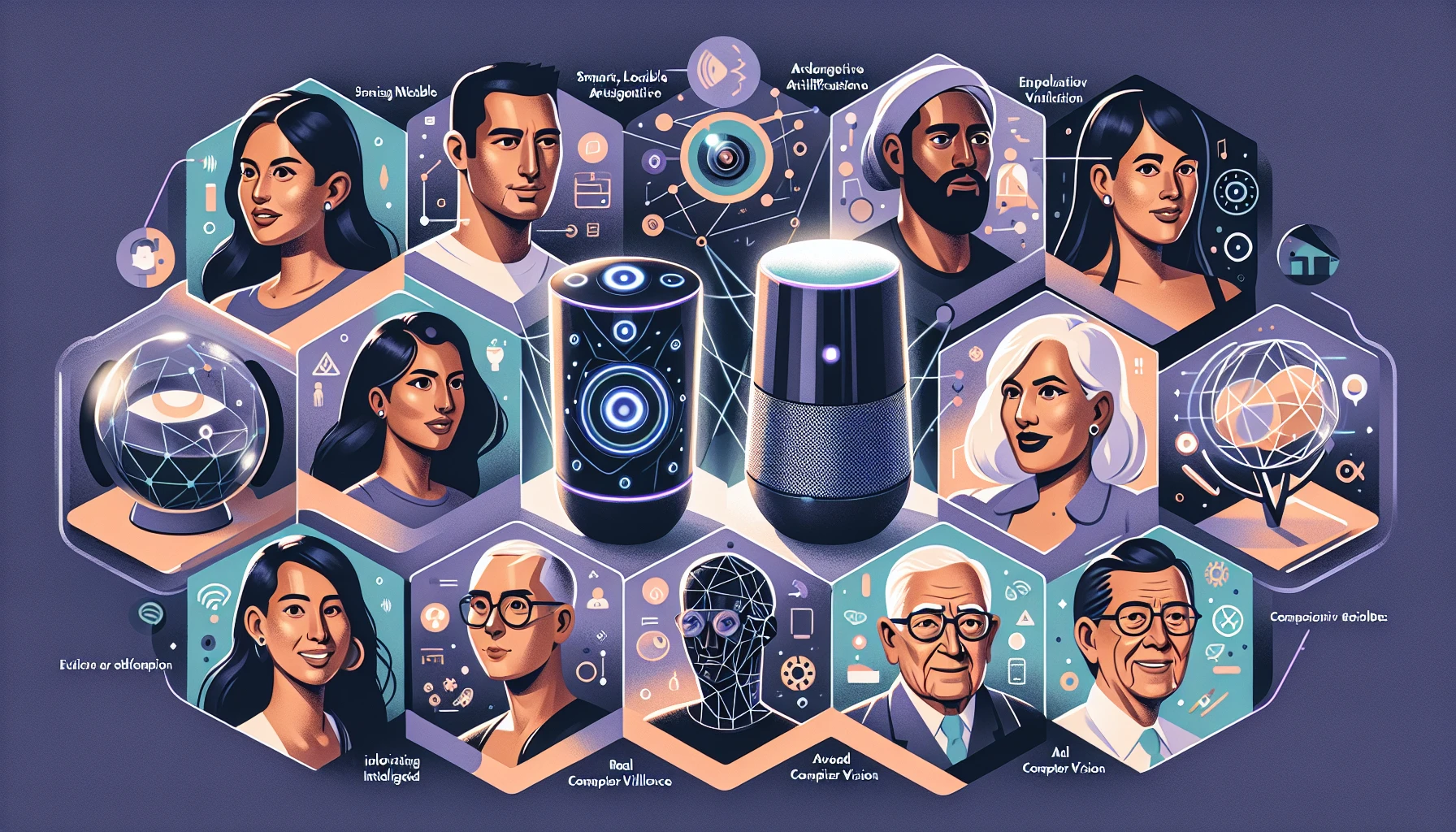In recent years, voice-based computing has faced numerous failures from major tech companies. Microsoft’s Cortana and Amazon’s Alexa both experienced significant setbacks and monetary losses. Despite these failures, there is still immense potential in talking to computers. Many new companies are claiming to revolutionize voice-based computing and bring it to new heights.
The past failures in voice-based computing should not discourage us from exploring the possibilities of this technology. Science fiction has long depicted a future where humans interact seamlessly with computers through speech. This vision has inspired a new wave of companies, such as Humane and Meta, to develop innovative voice-based computing systems.
These new companies are introducing several advancements that differentiate them from previous voice-based computers. Firstly, they incorporate real generative AI, making them significantly smarter and more flexible in understanding and responding to user commands. This eliminates the need for specific phrases or commands, allowing for more natural and intuitive interactions.
Secondly, these devices are equipped with advanced computer vision capabilities, enabling them to analyze and interpret visual information. This opens up possibilities for tasks such as estimating nutritional content, providing cooking instructions, and assisting with other visual-based activities.
Lastly, these new voice-based computers are wearable and always on, minimizing the friction of interacting with them. This makes them particularly useful for individuals with visual impairments or those who may struggle with traditional computer interfaces.
While these advancements are promising, it is essential to critically assess the claims made by companies like Humane. Their assertion that voice AI will replace smartphones and become the future of personal computing is unrealistic. Voice interaction has inherent limitations, such as privacy concerns, limited information delivery, and the lack of precision in spoken language.
However, when used as a complementary tool or for specific tasks, voice-based computing can enhance our overall computing experience. By recognizing the strengths and limitations of this technology, we can harness its potential and create a more seamless and efficient user experience.
Advancements in Voice-Based Computing
As technology continues to evolve, voice-based computing is undergoing significant advancements that bring us closer to the vision of seamlessly interacting with computers through speech. These advancements are transforming the landscape of voice-based computing and opening up new possibilities for users.
Generative AI in Voice-Based Computers
One of the key advancements in voice-based computing is the incorporation of generative AI into these systems. Unlike previous voice assistants that relied on pre-programmed answers to specific questions, the new generation of voice-based computers utilizes real generative AI. This makes them smarter and more flexible in understanding and responding to user commands. Users no longer need to use specific phrases or commands, allowing for more natural and intuitive interactions.
Advanced Computer Vision Capabilities
Another significant advancement in voice-based computing is the integration of advanced computer vision capabilities. These devices are equipped with cameras that can analyze and interpret visual information. This opens up a whole range of possibilities, such as estimating nutritional content, providing cooking instructions based on what the camera sees, and assisting with other visual-based activities. These capabilities enhance the overall user experience and make voice-based computing even more versatile.
Wearable Devices for Easier Interaction
The new wave of voice-based computers is designed to be wearable and always on, making interaction with them much easier. These devices minimize the friction of interacting with traditional computer interfaces, making them particularly useful for individuals with visual impairments or those who struggle with traditional input methods. With wearable devices, users can seamlessly interact with their voice-based computers without the need for screens or physical keyboards.
These advancements in voice-based computing show great promise for the future. While these technologies may not replace smartphones or become the sole interface for general computing, they serve as complementary tools that enhance the overall computing experience. By recognizing the strengths and limitations of voice-based computing, we can harness its potential and create a more seamless and efficient user experience.
Flaws in the Voice-First Approach
While there are many advancements in voice-based computing that show promise, it is important to acknowledge the flaws in the voice-first approach. These limitations can impact the overall user experience and hinder the widespread adoption of voice-based computing.
Inconvenience of Voice-Only Setup and Input Methods
One of the main drawbacks of relying solely on voice-based interaction is the inconvenience of the setup process and input methods. Voice-only devices often require initial setup through a separate device with a screen and precise input methods. This can be cumbersome and impractical, especially for individuals who are visually impaired or have difficulty using traditional computer interfaces. Additionally, inputting complex information like email addresses or passwords using voice commands can be time-consuming and error-prone.
Privacy Concerns
Voice-based computing raises significant privacy concerns. Interacting with a voice-based device means that your conversations are being recorded and analyzed by the device and potentially by the companies behind them. This raises questions about data security and the potential for unauthorized access to personal information. Furthermore, using voice commands in public spaces can compromise privacy, as sensitive information may be overheard by others.
Limitations in Complex Tasks and Productivity
While voice-based computing excels in simple tasks like setting timers or controlling smart home devices, it falls short when it comes to more complex tasks and productivity. Voice commands are not as precise or efficient as using a traditional computer interface. Tasks like editing documents, coding, or working with spreadsheets require more than just voice commands. Visual feedback and precise inputs are necessary for these tasks, which voice-based devices struggle to provide.
Inability to Handle Visual Content Effectively
Another limitation of the voice-first approach is the inability to handle visual content effectively. Voice-based devices may have limited or no screens, which makes it difficult to display visual information like images, videos, or maps. This restricts the user’s ability to consume visual content, which is an essential part of many tasks and activities. It also limits the device’s ability to provide visual feedback or interact with visual interfaces.
While voice-based computing has its strengths, it is important to recognize the flaws and limitations of this approach. Voice-only devices may be inconvenient to set up and use, raise privacy concerns, struggle with complex tasks and productivity, and have limitations in handling visual content effectively. By understanding these limitations, we can make more informed decisions about incorporating voice-based computing into our daily lives.
Voice as an Addition, not a Replacement
Voice-based computing has the potential to enhance our overall computing experience, but it should be seen as an addition, not a replacement for smartphones. While companies like Humane claim that voice AI will replace smartphones and become the future of personal computing, this assertion is unrealistic. Voice interaction has inherent limitations that make it unsuitable for certain tasks and activities.
However, when used as a complementary tool or for specific tasks, voice-based computing can greatly enhance our computing experience. Here are a few examples of how voice can be a valuable addition to smartphones:
Voice as a Complementary Feature to Smartphones
- Quick interactions: Voice-based commands are perfect for quick tasks like setting timers, checking the weather, or controlling smart home devices. These interactions can be performed effortlessly without the need to physically interact with a screen or keyboard.
- Accessibility: Voice-based computing is a game-changer for individuals with visual impairments or those who struggle with traditional computer interfaces. Wearable devices like Meta’s Rayband glasses provide a hands-free and always-on experience, making computing more accessible for everyone.
- Efficient multitasking: Voice commands allow for multitasking without interrupting your workflow. You can make a phone call, send a text message, or play music while performing other tasks, keeping your hands free and your focus intact.
Meta’s Rayband Glasses
Meta’s Rayband glasses are an excellent example of how voice-based computing can be integrated with smartphones. These glasses serve as a wearable device that pairs with your phone, providing a seamless and hands-free computing experience. With advanced computer vision capabilities, the glasses can analyze and interpret visual information, opening up possibilities for tasks like estimating nutritional content, providing cooking instructions based on what the camera sees, and assisting with other visual-based activities.
Microsoft’s Hololens
Microsoft’s Hololens is another example of how voice-based computing can be an additional capability rather than a replacement for smartphones. The Hololens is a mixed-reality device that allows users to interact with virtual objects using voice commands. It’s particularly useful for complex tasks like maintenance scenarios, where users need to use both hands while relying on voice commands to control the device. By combining voice interaction with augmented reality, the Hololens enhances productivity and efficiency in specific use cases.
In conclusion, voice-based computing should be seen as an addition to smartphones rather than a replacement. While voice interaction has limitations, it can greatly enhance our computing experience when used for quick interactions, accessibility, and efficient multitasking. Devices like Meta’s Rayband glasses and Microsoft’s Hololens demonstrate the potential of voice as an additional capability, providing new ways to interact with technology and improving overall user experience.
Voice AI with a Screen and Precise Input Methods
Voice-based computing has seen significant advancements in recent years, but there are still limitations that need to be addressed to make it a more versatile and practical interface for users. One potential solution is to add a screen and precise input methods to voice-based devices, reinventing the smartphone and creating a more comprehensive user experience.
Adding a Screen and Precise Input Methods
By incorporating a screen and precise input methods into voice-based devices, users can enjoy the benefits of both voice interaction and visual feedback. This combination allows for more precise and efficient interactions, especially when performing tasks that require complex inputs or visual content.
The addition of a screen enables users to view visual information, such as images, videos, or maps, which is essential for many tasks and activities. It also provides a more intuitive and familiar interface for users who are accustomed to traditional computer interfaces.
Precise input methods, such as a physical keyboard or touch-sensitive screen, allow for more accurate and efficient inputting of complex information. Tasks like typing emails, entering passwords, or editing documents become much easier and faster with precise input methods.
Reinventing the Smartphone
By adding a screen and precise input methods to voice-based devices, we can reinvent the smartphone and create a new form factor for personal computing. This combination of voice interaction, visual feedback, and precise input methods offers a more comprehensive and seamless user experience.
With a voice-first interface complemented by a screen and precise input methods, users can enjoy the best of both worlds. They can perform quick interactions with voice commands, such as setting timers or controlling smart home devices, while also having the option to utilize the screen and precise input methods for more complex tasks and activities.
This reinvented smartphone can provide a more versatile and efficient platform for general computing, offering users a wide range of capabilities and possibilities. It combines the convenience and naturalness of voice interaction with the precision and visual feedback of traditional computer interfaces.
The Limitations of Voice as a Precise Input Method
While voice-based computing has its strengths, it also has inherent limitations as a precise input method. Speech is not as precise or efficient as using a traditional computer interface for certain tasks that require complex inputs or precise adjustments.
Tasks like coding, editing documents, or working with spreadsheets often require visual feedback and precise inputs that voice-based devices struggle to provide. The lack of a physical keyboard or touch-sensitive screen can hinder productivity and make these tasks more time-consuming and error-prone.
Additionally, voice-based devices may have limitations in handling visual content effectively. Without a screen, it becomes challenging to display visual information like images, videos, or maps, limiting the user’s ability to consume and interact with visual content.
By recognizing the limitations of voice as a precise input method, we can better understand the importance of incorporating a screen and precise input methods into voice-based devices. This combination offers a more comprehensive and efficient user experience, reinventing the smartphone and paving the way for the future of personal computing.
Conclusion
The potential of voice-based computing is undeniable. While major tech companies have faced setbacks in this field, new advancements show promise for the future. Companies like Humane and Meta are introducing innovative voice-based computing systems that incorporate generative AI, advanced computer vision capabilities, and wearable devices.
However, it is important to recognize the limitations of voice-based computing. Voice-only setups can be inconvenient and pose privacy concerns. Complex tasks and productivity may be hindered by the lack of precise inputs and the inability to handle visual content effectively.
Despite these limitations, voice-based computing can enhance our overall computing experience when used as a complementary tool or for specific tasks. Quick interactions, accessibility for individuals with visual impairments, and efficient multitasking are just a few examples of how voice can be valuable.
I would recommend iFixit for Black Friday deals instead of investing in voice-based computing devices. iFixit offers repair kits and tools that empower users to fix their existing devices, reducing e-waste and providing control over their gadgets. With over 100,000 free manuals and repair guides, iFixit is a reliable resource for repairing electronics, appliances, cameras, cars, and more.
In conclusion, while voice-based computing has its potential, it is important to approach it as an addition, not a replacement for smartphones. By recognizing the strengths and limitations of voice-based computing, we can empower users with repair and control over their devices, creating a more seamless and efficient user experience.



